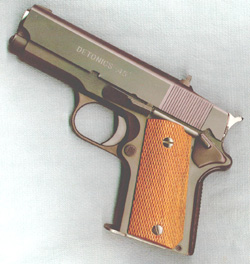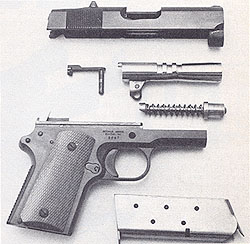Material gathered by Rick Brenemen

The Detonics Combat Master was the first really small and compact 1911-pattern pistol to be produced in significant numbers. Law enforcement fell in love with it immediately due to its diminutive size and quality. It received “star quality” when Don Johnson as Sonny Crockett in Miami Vice was seen carrying one in a leg holster in the show. Far more important than the media exposure was the revolutionary reliability work done inside the pistol. The Detonics introduced the bulged barrel end so that the pistol did not require a bushing. It also incorporated double and triple recoil springs. It was the first production 1911-pattern which was throated and ramped for hollowpoints. The high price and limited market for the pistol doomed the company, but were the Combat Master to be reintroduced today, it would no doubt be a different story. Those fortunate enough to own a Detonics pistol treasure them.
The Gun
“The concept of the original Detonics was simply a stainless single action pistol. The big guns came after the little gun. Detonics was actually started with the Combat Master. Before Detonics, mini-pistols were all built by hand; they were cut-down Colts. The driving force behind the original company was to build a small, manufacturable production .45 ACP pistol and that was Sid Woodcock’s baby. He was the daddy of the Combat Master. He came up with that idea sitting around on a beach with Chuck Lyford somewhere down in South America in the mid ‘70’s. So Chuck introduced Sid to some money people in Seattle, and Detonics was started.”
Robbie Barrkman, 1991
“(Woodcock) got together with some friends and set about to improve the basic Colt/Browning design in such a manner that a gun could be mass-produced with not only the classic custom modifications already in place, but of a reduced size for easier concealment and reengineered to be more reliable and easily managed than the original. The firm that grew out of this attempt to make good better was Detonics (.45 Associates) of Seattle, Washington. Detonics originally offered a blued, ordnance steel Colt/Browning-style .45 of about the same size as a Walther PP. The gun featured a beveled magazine well, hammers of various peculiar shapes, a pre-pinned grip safety, a butt shortened to handle a six-round magazine rather than a seven (which could still accept full-size magazines as spares), a slide and barrel length much shorter than Colt’s Commander and slicked-up internal parts which allowed the gun to handle hollowpoints and hardball with equal aplomb. The barrel was bulged at the muzzle to facilitate the bushingless design, self-centering to mate with the slide. The (Colt) standard single recoil spring was replaced by a recoil spring guide with (two, and later three) separate counter-wound recoil springs. The six-round magazine featured a loaded magazine indicator. This was advertising hype to compensate for necessity. To give full support for a six-round capacity in so small a magazine, it was necessary that with the gun fully loaded a thumbnail-sized piece would protrude from the rear of the magazine base plate, to disappear again once the magazine went one round lighter. The first of these guns used cut-down Colt parts. The little guns caught on. Soon, various models were offered – adjustable sights, .38 Super and 9mm, etc. Then Detonics did something really radical. Detonics began to offer the little gun – by now known as the Combat Master – in stainless steel.”
Jerry Ahern, Petersen’s Handguns, 7/90

“The Detonics pistol, now in limited production and geared for full production the first of the year (1975) at Detonics .45 Associates, Seattle, is a short, compact, all-steel, single-action, single-column variation of the Browning/Colt of 1911. Various parts (slide-stop and thumb-safety assembly, magazine release, trigger, sear, disconnector, etc.) are interchangeable. While the butt is too short to include the standard seven-shot Colt magazine, such magazines are entirely functional and might be preferably carried as spares. The little gun is 6 ¾” long by 4 5/8″ inches deep, and its width is exactly that of the service auto. The . . . rear sight is set oddly forward, reducing the sight radius to a bare 4 inches. Admitting that this is no target pistol, it does seem odd to deliberately aggravate what is already a drawback. The Detonics pistol is a strong, simple, rather heavy – due to its all-steel construction – example of the type, with the distinct virtue of utilizing many standard Colt parts and employing neither exotic nor untried mechanical systems. Standard price $399.”
Jeff Cooper, Guns & Ammo, 12/74
“This remarkable pistol is the smallest, lowest recoil single action .45 caliber semi-automatic in the world. The Detonics .45 is a premium quality professional tool for the serious handgun expert and combat shooter. It is capable of providing the brute force stopping power of the standard-sized .45 in a size no larger than a snub-nosed .38, or “pocket” 9mm auto. The Detonics .45 has an advanced mechanism which reduces the apparent recoil remarkably below the full-sized .45. This awesomely powerful pistol is smaller, more easily concealed, and has greater short/medium range rapid fire accuracy than any single action .45 weapon available today. This masterpiece of combat design is gaining recognition as the finest defensive handgun in the world today.”
Detonics .45 Instruction Manual, 4/80
“The carbon steel production guns start at (serial) number 2000. The first 1999 numbers have been set aside for presentation and commemorative models. So, to determine the true production number of your pistol, subtract 2000 from your serial number. Stainless steel production numbers start at number 10,000.”
Detonics Instruction Manual
“Although there are six different models available to the general buying public, a Detonics is a Detonics is a Detonics. Only finish, type of material used and adjustable rear sight differentiate one model from another. The plain-Jane entrant is the Combat Master Mark I, attired in a matte blue finish, fixed sights, with a retail price of $369 (1980). Stepping up a notch, the Mark II is a fixed-sight model dressed in a satin nickel finish with a price tag of $390. The Mark III is handsome in its hard chrome appearance with fixed sights and sells for $488. Variation number IV is resplendent in a mirror-bright blue finish and adjustable rear sight, and $499 will allow the buyer to take one home. The Mark V is a brushed-finish, stainless steel model with fixed sights and will sell for $498 ($626, 1983). And, finally, the top-of-the-line model is the Presentation-grade, Professional Mark VI which boosts the price to $575 ($635, 1983)[There was eventually also a sightless Mark VII, also $635 in 1983].”
Art Blatt, Guns & Ammo, 5/80
“The original Detonics pistol, a modified and much smaller version of the Colt Model 1911, made it initial appearance in 1977. Billed as the world’s smallest single-action autoloader chambered for the .45 ACP cartridge, the Detonics Mark I was an instant hit with law enforcement officers. Not content with their original little .45 ACP powerhouse, the Detonics people went back to the drawing board and created a new cartridge that is a real blaster. The .451 Detonics Magnum is virtually identical in (external) dimensions to the .45 ACP, except for case length. The .451 Detonics is only some .050″ longer, but the added capacity is enough to allow considerably heavier powder charges to be used without exceeding safe pressure limits. According to the loading manual, four different propellants will produce velocities exceeding 1,300 feet per second from a 185-grain bullet. The Detonics manual specifically states that seating depth is critical. Overall cartridge length must lie between 1.220 and 1.235 inches, using bullets no longer than .558 inch. Average velocity for all four loads was 1,188fps vs. an average of 1,284 for velocities given in the manual. Since we did not use maximum loads, it may be assumed that velocities in the neighborhood of 1,300fps would be possible with careful load development. If a velocity in excess of 1,300fps is truly attainable with a 185-grain slug, the .451 Detonics would produce a muzzle energy of more than 700 foot pounds – a remarkable improvement of raw power over a factory-loaded .45 ACP. The base price of the pistol is $754 (1984).”
Ralph Glaze, Guns & Ammo, 2/84
Corporate Travail
“Detonics, specialists in stainless-steel for going on two decades, changed hands. An agreement was reached in early December ’86 between Diane McCarthy, Detonics’ General Manager, Ed “Tim” Lasater, Sales Manager and Energy Sciences Corp., for McCarthy and Lasater to take over the complete business, including all the Detonics handguns. McCarthy retains her title, while Lasater becomes President and CEO.”
Combat Handguns, 6/87
“The original Bellevue, Washington company ultimately floundered, and a group of investors led by Lyford bought Detonics assets out of bankruptcy. Lyford knew Robbie (Barrkman) from the latter’s tenure at Gunsite, and contacted him about getting involved with the new company.”
Waldo Lydecker, Guns Magazine, 8/91
“I said, ‘Well, you guys aren’t doing very much. What are you looking for? What are you trying to do? I really didn’t think it would work out, but promised to give it 100 per cent. They agreed, and in July of 1989 New Detonics was in business in Phoenix.
Robbie Barrkman, 1991
Detonics’ line of guns expanded from the Combat Master to include the Commander-sized Servicemaster, Government-sized Scoremaster, and the compensated, race-gun style Compmaster. I don’t really know how or why the company finally failed. All of the reviews of Detonics guns, as late as 1991 were positively glowing. They were VERY expensive. The Combat Master cost $400 when a Colt Commander cost $250. The top-of-the-line Compmaster target pistol, similar to the various custom “pin guns”, was over $1600 in 1991!
Parts Compatibility
Combat Master parts that are compatible with standard Colt Government Model production:
Extractor, firing pin and spring, magazine catch/spring/lock, slide stop/safety plunger assembly, plunger tube, trigger, mainspring housing, mainspring cap, mainspring housing pin retainer, mainspring cap pin, mainspring housing pin, stock screw/bushing, safety lock, hammer pin, sear pin, slide stop, barrel link/pin, disconnector, sear, hammer, hammer strut pin.
Combat Master parts that are different from similar Government Model parts:
Frame, slide, barrel, rear sight, firing pin stop, “grip plate” (grip safety), sear spring, magazine, stock panels, recoil spring guide, recoil spring cap (plug), recoil springs (two or three, depending on model).
Combat Master parts that are in addition to those above:
Recoil spring guide screw.
Sources for replacement parts, non-Colt standard:
“grip plate”, sear spring and hammer strut – Essex Arms
recoil springs – single, Wolff; dual, King’s Gun Works (Officers ACP recoil spring set).
stock panels – Gun Parts Corp.; “slim-line” grips, Brownells.
magazines – Metalform
barrels – Storm Lake Machine
firing pin stop – standard stop can be fitted, and cut flush with top of slide
Biggerhammer’s Detonics Page – Lots of good photos and technical information

Comments, suggestions, contributions? Let me know